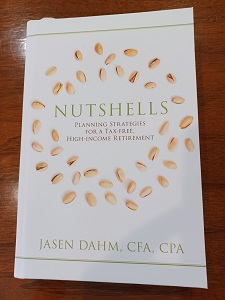
Photo credit: jb
Had an opportunity to read a new book over the tax season (in my spare time!). I found this book, by Jasen Dahm, CFA, CPA, to be a very good review of strategies to maximize your income and avoid taxes where possible, while planning your retirement income stream.
In today’s world, we’re for the most part on our own when it comes to planning our retirement income. Gone (mostly) are the days of company pensions taking care of the lion’s share of our retirement income needs. In the place of pensions are many different options, including 401(k), IRA, Roth-type accounts, Social Security, and insurance products, plus some outliers such as Health Savings Accounts and 529 plans. With proper planning, it is possible to maximize your retirement income stream, minimizing taxes along the way. This book is a very good guide to understanding the principles that can help you along that path.
Too often the tax-reduction concept is relatively short-sighted in most retirement planning models. When taken in the context of a lifetime process, real value can be provided with strategic planning.
Dahm uses excellent examples throughout the book to illustrate the concepts, with three different case studies that continue throughout the book. As each new concept is unveiled, the concept is applied to each of the case studies, with very good explanatory effect. These case studies are especially valuable to drive home the benefits of the strategies the author is explaining.
The goal is to produce a tax-free, high-income retirement. For most, the “tax-free” part is highly unlikely, but certainly possible, as illustrated by the author. (Personally, I’ll settle for a tax-reduced income, aiming toward tax-free if the circumstances work out properly!)
As is the bane of all financial writers, myself included, there’s nothing especially new in this book – very little changes about the mechanics of retirement investing and the like. However, the author uses his examples to provide what are perhaps some new insights into ways to strategize your initial and ongoing investment activities, as well as how to efficiently and effectively draw the funds from the various sources when the time comes.
I found this book to be an excellent primer for an all-around review of the options available to retirement investors, with extra emphasis on a few options that many gloss over.
For example, Dahm spends a good bit of time explaining the benefits of LIRP (life insurance retirement products), a topic that usually doesn’t get much emphasis if the writer isn’t vested in insurance sales. And if the writer is selling insurance, you wouldn’t typically get such excellent information about all of the other types of accounts that Dahm has painstakingly reviewed and explained here. (I have no idea if Mr. Dahm is in the business of insurance sales or not. Regardless, he does a good job of explaining the benefits without selling products. Kudos!)
In addition, the author also explains how to fit Health Savings Accounts (HSAs) and 529 plans into the overall scheme, something that often gets short shrift from many other authors. HSAs are often seen as an “extra” for many folks, and they’re often unsure of the benefits of such accounts. In this book, you can learn how these accounts and 529 (college savings) accounts can be integrated into your lifetime tax-saving activities, right alongside your 401(k) and other retirement saving activities.
All in all, I would highly recommend this book for investors (novice to experienced) and advisors. There are gems to be found within, and even if all of the concepts are well-known to the reader, I bet you’ll gain something by the review and fresh insight from this talented author. Novice investors can use this as a jumping-off point for understanding all of the options available to them; experienced investors can gain new insights into strategic asset positioning. Advisors will probably learn a thing or two as well.


 Sterling Raskie, MSFS, CFP®, ChFC®
Sterling Raskie, MSFS, CFP®, ChFC® The latest in our Owner’s Manual series, A 401(k) Owner’s Manual, was published in January 2020 and is available on
The latest in our Owner’s Manual series, A 401(k) Owner’s Manual, was published in January 2020 and is available on  A Medicare Owner’s Manual, is updated with 2020 facts and figures. This manual is available on
A Medicare Owner’s Manual, is updated with 2020 facts and figures. This manual is available on  Social Security for the Suddenly Single can be found on Amazon at
Social Security for the Suddenly Single can be found on Amazon at  Sterling’s first book, Lose Weight Save Money, can be
Sterling’s first book, Lose Weight Save Money, can be  An IRA Owner’s Manual, 2nd Edition is available for purchase on Amazon. Click the link to choose the
An IRA Owner’s Manual, 2nd Edition is available for purchase on Amazon. Click the link to choose the  Jim’s book – A Social Security Owner’s Manual, is now available on Amazon. Click this link for the
Jim’s book – A Social Security Owner’s Manual, is now available on Amazon. Click this link for the  And if you’ve come here to learn about queuing waterfowl, I apologize for the confusion. You may want to discuss your question with Lester, my loyal watchduck and self-proclaimed “advisor’s advisor”.
And if you’ve come here to learn about queuing waterfowl, I apologize for the confusion. You may want to discuss your question with Lester, my loyal watchduck and self-proclaimed “advisor’s advisor”.